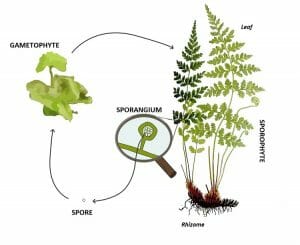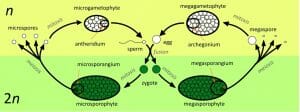What is Alternation of Generations
Alternation of generations is a type of life cycle found in terrestrial plants and some algae in which subsequent generations of individuals alternate between haploid and diploid organisms. This can be contrasted to sexual reproduction in animals, in which both haploid and diploid cells are found in every generation. Alternation of generations has several distinct features, and these features can be slightly modified between species. In general, the generations alternate between the sporophytes capable of creating spores and the gametophytes, capable of creating gametes.
Alternation of Generations Life Cycle
Sporophyte
To form a sporophyte, two haploid gametes come together to form a diploid zygote. Typically, haploid organisms are defined by having an “n” number of chromosomes. When two gametes of the same species come together, they each have n chromosomes. Therefore, the diploid zygote which forms is considered to have 2n worth of genetic material, or exactly twice as much. Not only is there twice as much DNA, but it represents codes for the same proteins in the same organism. The sporophyte is a multicellular organism formed from multiple rounds of mitosis on the zygote. Thus, the sporophyte individual remains a 2n organism.
Then, when the sporophyte reaches maturity, a key point in the alternation of generations takes place. The sporophyte develops organs, known as sporangia. These specialized reproductive organs are used to create single-celled, haploid spores. These cells will be released into the air or water and carried away. When they reach a suitable environment, they will begin the process of developing into the gametophyte.
Gametophyte
This represents the next generation in the alternation of generations, as the haploid spore is created. The spore is technically a new organism, and has only half the DNA as the parent organism. This spore will undergo successive rounds of mitosis to form a new multicellular individual, the gametophyte. Where the sporophyte generation creates spores, the gametophyte generation creates gametes. Gametes are produced by special organs on the gametophyte, the gametangia. These gametes are then broadcast into the environment, or transferred between plants.
When they find an opposite gamete, they begin the process of fusing to form another zygote. This zygote will eventually become a sporophyte, and the alternation of generations will keep turning. While this is a simplistic version of the alternation of generations, there are many complexities, which will be discussed below. Because of these complexities, and because all plants undergo some version of alternation of generations, scientists prefer to refer to other aspects of their reproductive cycles to define the species.
The simplest form of alternations of generations is found in the fern, as seen below. As seen in the diagram, the gametophyte and sporophyte are clearly different individuals. This is not always the case.
Complications with Alternation of Generations
Gendered Gametes
There are many additional factors which can complicate this basic theme of alternation of generations. The most notable complication is gender. Both sporophytes and gametophytes can have genders. Further, the sporophyte or gametophyte may not be totally independent of the other generation. Consider flowering plants for example. Some flowers have both male and female gametophytes housed within. In other flower species, the male and female flowers are separated, but may be present on the same plant. In still other flowers, individual sporophytes only give rise to a certain gender of flower.
The terms monoicous and dioicous are used to describe the gametophytes. If both genders are housed on the same individual, the species is monoicous. If they are separated, the alternation of generations is dioicous. This applies only to the gametophyte.
In the sporophyte, the terms used are monoecious and dioecious. Here, these describe whether the sporophyte will produce both genders, or if the genders are separated into different sporophytes. It is important to note that many plants are monoecious, but dioicous. This means that a single sporophyte can produce both male and female flowers. Many other combinations of these differences in the alternation of generations can be observed in various plant and algae species.
Differences in the Sporophyte and Gametophyte
During the alternation of generations in some species, there is an unequal distribution in size or dominance of either the sporophyte or the gametophyte. In different species, this can be reversed. In liverworts the gametophyte is the dominant generation. Liverwort is a gametophytic plant. In ferns, the opposite is true and the sporophyte is the larger, more dominant individual. This would be called a sporophytic plant.
In other species, the size and shape of the sporophyte and gametophyte is nearly indistinguishable. The only difference is the amount of DNA they carry and whether they will produce spores or gametes. While this may seem like they aren’t really doing anything, alternation of generations still allows sexual reproduction to occur. This greatly mixes the genes and increases the adaptability of the species.
Sporophytes and gametophytes from different species also produce different types of spores and gametes. If the gametes are the same, it is called isogamy. Some species of green algae produce only one type of gamete. These are both flagellated and swim in open water until they find each other. This scheme is not particularly useful for terrestrial plants. Most terrestrial plants show anisogamy, or a difference in their gametes. This is most commonly seen as the difference between the mobile male gamete and the larger, immobile female gamete, or sperm and oocytes. Other times, it is seen as a size difference only.
Below is a graphic representation of a dioicous, dioecious, anisogametic plant. This means that the plant has separate individuals of both gametophytes and sporophytes, and that the gametes it produces are of different sizes. This would be true of a holly or willow tree, which produces separate male and female flowers, on separate individual sporophytes.
Evolution of the Alternation of Generations
Fossil evidence, and the existence of many algae with simplified alternation of generation life cycles, hints that the evolutionary advantage of sexual reproduction through the alternation of generations is what made terrestrial plants adaptable enough to colonize the land. The alternation of generations allows for both the dynamic and volatile act of sexual reproduction and the steady and consistent act of asexual reproduction.
When the sporophyte creates spores, the cells undergo meiosis, which allows the gametophyte generation to recombine the genetics present. This allows for great diversity to arise. As plants colonized the land, they were initially isomorphic, or both the gametophytes and sporophytes looked and acted about the same. As time progressed, most plants found it beneficial to reduce one of these life cycles. Most flowering plants now have a much reduced gametophyte life cycle, while liverworts and mosses went the other way, preferring to diminish the sporophyte cycle. In the wide variety of plants alive today there is almost every variation of the alternation of generations conceivable.
Quiz
1. What is one advantage of the alteration of generations over an asexual species?
A. Asexual species have very little genetic recombination
B. There are no advantages
C. It is easier to reproduce
2. What is the difference between the alternation of generations seen in plants and the sexual reproduction seen in mammals?
A. Mammals only alternate every other generation
B. Mammals do not alternate generations
C. Mammals produce sperm and eggs, where plants do not
3. Is it better to have a more dominant sporophyte or a more dominant gametophyte?
A. Sporophyte
B. Gametophyte
C. Neither!
References
- Brusca, R. C., & Brusca, G. J. (2003). Invertebrates. Sunderland, MA: Sinauer Associates, Inc.
- Hartwell, L. H., Hood, L., Goldberg, M. L., Reynolds, A. E., & Silver, L. M. (2011).Genetics: From Genes to Genomes. Boston: McGraw Hill.
- McMahon, M. J., Kofranek, A. M., & Rubatzky, V. E. (2011). Plant Science: Growth, Development, and Utilization of Cultivated Plants (5th ed.). Boston: Prentince Hall.
Alternation of Generations


No comments:
Post a Comment